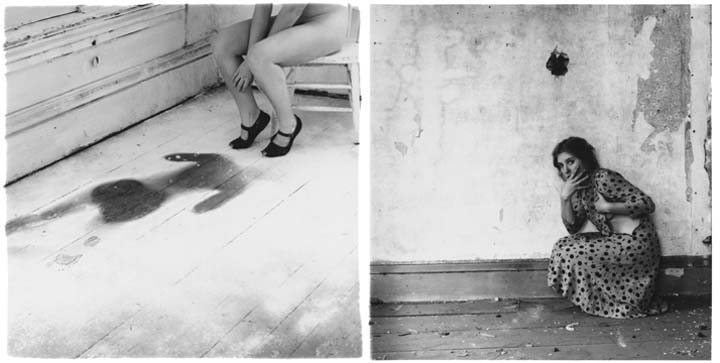Francesca Woodman: Body and Soul

Left: Untitled, Providence, Rhode Island, 1976. Right: Polka Dots, November 1976. Courtesy and copyright © 2012 George and Betty Woodman.
In the brief span of less than a decade, Francesca Woodman (1958-1981) produced a complete body of work in photography. From the time she picked up a camera as a teenager, she made herself the main subject of her work. She plumbed and reconfigured the genre of self-portraiture, through mysterious performances that are haunting and intimate explorations of photographic time, the body in space, femininity, and her beautiful nude figure as a blank form on which to create a new direction in photography.
As the daughter of practicing artists, Woodman was well aware of what an artist’s life entailed when she entered the Rhode Island School of Design (RISD) in 1972. Using a square format camera and black-and-white film, early on she developed a consistent working method that exploits seriality, surrealism, and recalls the late-19th-century genre of spirit photography.
Inspired by her attraction to gothic literature, she staged events in decrepit rooms where, using her body to define space, she simultaneously created sculptural and architectural form in serial images that were more novelistic than diaristic. Alternating between the material (her naked body encrusted in dirt, blotched with paint, or tightly taped, Hans Bellmer-style) and the ethereal (her naked body caught in a blur of movement that suggests an ascending angel), she used self-study to dematerialize physicality, a photographic construct of disappearing from the scene.
Woodman often printed the same image several different ways, arriving at a signature look that encompasses a broad and luminous tonal scale. She worked independently from the outset, setting up her studio in an abandoned store off campus, where she spent most of her time although it was not set up for living. When she went to Rome for her junior year, in 1980, she was secure in her working methods, made friends with a group of students, and discovered a second hand bookstore. There she unearthed a treasure trove of surrealist texts, found photographs, and used notebooks that she transformed into imaginative artist books, two of which are on view at the Guggenheim.
After graduation, Woodman moved to New York and attempted to make a career in fashion photography, which she soon abandoned. In 1980 she began a series of large-scale figure studies, including Caryatid, several of which she printed with the diazo, or blueprint, process used by architects. These nearly eight-foot-high images are a reinterpretation of themes she was already working with as a student in Providence, yet seemed to herald a new direction for her. However she ended her life at 22 in 1981 and her work was unknown until it was shown at the Wellesley Art Museum in 1987.
Until the current exhibition opened last fall at SF MoMA, where it was organized by curator Corey Keller, the cult that had formed around Woodman was based just 50 or so images that had come to llight. In viewing the more than 120 photographs now on view (from a collection of nearly 600 prints that curator Keller had access to), a different picture of the artist emerges and her place in photography has been securely anchored at a moment when artists everywhere were reinventing the medium of photography.
Francesca Woodman continues through June 13 at the Guggenheim Museum, 1071 Fifth Avenue, at 89th Street, NY, NY.
03212012


